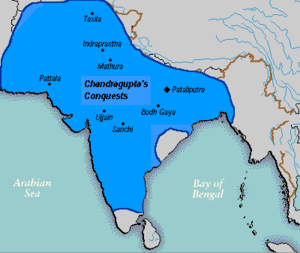Kalinga War
| The Kalinga War | |||||||||
|---|---|---|---|---|---|---|---|---|---|
| |||||||||
| Belligerents | |||||||||
| Maurya Empire | Kalinga | ||||||||
| Commanders and leaders | |||||||||
| Ashoka | Unknown | ||||||||
| Strength | |||||||||
| Total 70,700 |
6,000 infantry,[2] | ||||||||
| Casualties and losses | |||||||||
| 10,000 |
50,000 (figures by Ashoka)[4][5] | ||||||||
The Kalinga War (ended c. 262 BCE)[1] was fought in what is now India between the Maurya Empire under Ashoka and the state of Kalinga, an independent feudal kingdom located on the east coast, in the present-day state of Odisha and north of Andhra Pradesh . The Kalinga War included one of the largest and bloodiest battles in Indian history. Despite an unexpectedly fierce resistance from the Kalingans, the Maurya Empire claimed victory and annexed the state of Kalinga. Kalinga did not have a king as it was culturally run without any.[6]
This is the only major war Ashoka fought after his accession to the throne. The bloodshed of this war is said to have prompted Ashoka to adopt Buddhism.
Background

The reasons for invading Kalinga were both political and economic. Kalinga was a prosperous region consisting of peaceful and artistically skilled people. Known as the Utkala,[7] they were the first from the region who traveled offshore to the southeast for trade. For that reason, Kalinga had important ports and a powerful navy. They had an open culture and used a uniform civil code.[8]
Kalinga was under the rule of the Nanda Empire until the empire's fall in 321 BCE.[9] Ashoka's grandfather Chandragupta Maurya had previously attempted to conquer Kalinga, but had been repulsed. Ashoka set himself to the task of conquering the newly independent empire as soon as he felt he was securely established on the throne.[8] Kalinga is an ancient name of coastal Orissa.
Course of the war

No war in the history of India as important either for its intensity or for its results as the Kalinga war of Ashoka. No wars in the annals of the human history has changed the heart of the victor from one of wanton cruelty to that of an exemplary piety as this one. From its fathomless womb the history of the world may find out only a few wars to its credit which may be equal to this war and not a single one that would be greater than this. The political history of mankind is really a history of wars and no war has ended with so successful a mission of the peace for the entire war-torn humanity as the war of Kalinga.
The war was completed in the eighth year of Ashoka's reign, according to his own Edicts of Ashoka, probably in 262 BCE.[1] After a bloody battle for the throne following the death of his father, Ashoka was successful in conquering Kalinga – but the consequences of the savagery changed Ashoka's views on war and led him to pledge to never again wage a war of conquest.
Aftermath

Ashoka had seen the bloodshed and felt that he was the cause of the destruction. The whole area of Kalinga was plundered and destroyed. Some of Ashoka's later edicts state that about 100,000 people died on the Kalinga side and an almost equal number of Ashoka's army, though legends among the Odia people – descendants of Kalinga's natives – claim that these figures were highly exaggerated by Ashoka. As per the legends, Kalinga armies caused twice the amount of destruction they suffered. Thousands of men and women were deported.
Beloved-of-the-Gods, King Priyadarsi, conquered the Kalingas eight years after his coronation. One hundred and fifty thousand were deported, one hundred thousand were killed and many more died (from other causes). After the Kalingas had been conquered, Beloved-of-the-Gods came to feel a strong inclination towards the Dharma, a love for the Dharma and for instruction in Dharma. Now Beloved-of-the-Gods feels deep remorse for having conquered the Kalingas.
Ashoka's response to the Kalinga War is recorded in the Edicts of Ashoka. The Kalinga War prompted Ashoka, already a non-engaged Buddhist, to devote the rest of his life to ahimsa (non-violence) and to dharma-vijaya (victory through dharma). Following the conquest of Kalinga, Ashoka ended the military expansion of the empire and began an era of more than 40 years of relative peace, harmony, and prosperity. Oral histories of the region have attributed his devotion to Buddhism after the war to a woman who approached him and said, "Your actions have taken from me my father, husband, and son. Now what will I have left to live for?"
See also
References
- 1 2 3 Le Huu Phuoc, Buddhist Architecture, Grafikol 2009, p.30
- 1 2 Pliny the Elder (77 CE), Natural History VI, 22.1, quoting Megasthenes (3rd century BCE), Indika, Fragm. LVI.
- ↑ Roy, Kaushik. Military Manpower, Armies and Warfare in South Asia. Google Books. Routledge, 2015. Retrieved 17 August 2015.
- ↑ Ashoka (r. 268–231 BCE), Edicts of Ashoka, Major Rock Edict 13.
- ↑ Radhakumud Mookerji (1988). Chandragupta Maurya and His Times. Motilal Banarsidass Publ. ISBN 81-208-0405-8.
- ↑ "Detail History of Odisha".
- ↑ Das, Manmatha Nath (1949). Glimpses of Kalinga History. Calcutta: Century Publishers. p. VII; 271. Archived from the original on 4 June 2016. Retrieved 16 May 2016.
- 1 2 Ramesh Prasad Mohapatra(1986) Page 10. Military History of Orissa. Cosmo Publications, New Delhi ISBN 81-7020-282-5
- ↑ (Raychaudhuri & Mukherjee 1996, pp. 204-209, pp. 270–271)
- ↑ Ramesh Prasad Mohapatra (1986) Page 12. Military History of Orissa. Cosmo Publications, New Delhi ISBN 81-7020-282-5
- ↑ Allen, Charles (2012). Ashoka: The Search for India's Lost Emperor. Little, Brown Book Group. p. 82. ISBN 9781408703885. Retrieved 1 May 2018.